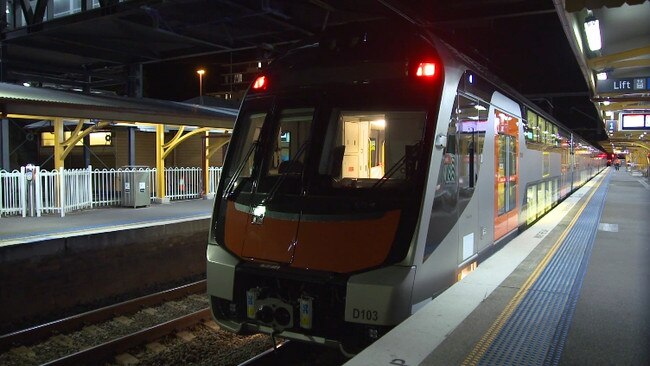New Intercity Fleet: Sydney Trains emergency button to ‘divert to call centre’
New intercity trains will see passengers who hit the emergency alert button diverted to a call centre as a damning government report revealed NSW TrainLink’s concerns around safety requirements. SEE THEIR WARNINGS HERE.

Local
Don't miss out on the headlines from Local. Followed categories will be added to My News.
- Union demands investigation into ‘shaky’ metro trains
- Electric freight trains to rumble under homes in Orbital tunnel
Rail workers have raised safety concerns on the New Intercity Fleet of trains after it was revealed emergency alert buttons on the fleet wouldn’t patch passengers through to the driver or guard on the train.
Instead, commuters on the trains — currently being tested at night on the Richmond line — will be contacting a call centre tasked with managing 55 new trains, 550 carriages, and announcements across the network.
The change to how emergency systems operate comes as new crime statistic data revealed a whopping 962 incidents of assaults on trains were recorded during 2019, in the first three months of this year alone, 277 people were assaulted on our rail network. While incidents of sexual and indecent assaults reached 358 cases in 2019.

The new fleet of trains will run on intercity lines linking Newcastle, Mt Victoria, Lithgow, Gosford and Wollongong to Central Sydney.
A Transport for NSW spokeswoman confirmed help buttons on the train will direct commuters to a “co-ordination centre located within the Rail Operations Centre at Green Square”.
“The New Intercity Fleet has enhanced safety features including eight internal and four external CCTV cameras per carriage, linked to a dedicated co-ordination centre,” she said.
MORE FROM JAKE McCALLUM
GOVT ‘GAVE UP’ LAND PLANNED FOR SYDNEY HOSPITAL
‘YOUNG DOCTORS COMMITTING SUICIDE OVER WORKLOADS’
POP-UP DEMOUNTABLE PRIMARY SCHOOL SLAMMED AS ‘POOR PLANNING’
GREEN LIGHT: MASSIVE LOGISTICS HUB TO BE BUILT NEXT TO AIRPORT
“A Customer Service Coordinator will be the first point of contact for on-board customers — as part of their role they will provide real-time support taking calls via on-board help points, monitor customer conditions on our network via CCTV, and provide information to customers, drivers and crew including on-board announcements.”
The spokeswoman said the CCTV meant guards didn’t have to lean out of the door of the train to inspect the platform.
“These cameras allow drivers and guards to easily monitor the entire length of the train, even on curved platforms and in bad weather,”she said.
“This provides a more contemporary method for monitoring train platforms which is used around the world.
“The trains are also equipped with Automatic Selective Door Operation, which ensures only the customer doors adjacent to a platform can open and sensitive door edge technology which reopens doors when it detects an obstruction. Traction interlocking on doors also stops the train from moving while the door is open.”

However, rail union boss, Alex Claassens, said the South Korean-built trains are designed as “driver-only”, with the proposed operating model removing safety responsibilities from the guard and placing them on the driver.
“We believe it would pose an unnecessary and unacceptable risk to the safety of passengers and train crew,” Mr Claassens told NewsLocal.
“Transport for NSW is attempting to remove the “guard” role as we know it and replace it with a new position that functions at a lower classification, reflecting the reduction of
safety responsibilities.
“In the meantime, the driver will have to take on a number of these responsibilities, including
opening and closing the doors, monitoring the safety of passengers as they enter and leave the
train, assisting customers where appropriate, as well as driving the train.”

Mr Claassens said guards will no longer be the first point of call for passenger contact on trains.
“The emergency button will instead be directed to a central and remote call centre, which can only manage so many calls at any one time,” he said. “Announcements that are not prerecorded will be managed from this call centre.”
Mr Claassens said train guards on the new fleet will not stand outside the train door to monitor the platform for slip, trip and fall risks during train departure, instead “they will be
locked in the crew cab and assess the train doors via CCTV only”.
“There will be no mandated visual inspection of the platform on arrival and departure,” he said.
He said 90 per cent of surveyed rail workers told the union they would refuse to work on the new trains due to “concerns about commuter safety”.
Shadow transport spokesman Chris Minns said safety should always be the NSW Government’s number one concern: “it shouldn’t matter whether it’s a city train or a regional train”.

“Andrew Constance needs to listen to the concerns of commuters and the people who will be working on these trains to address this problem,” he said.
“Many of the problems with these trains could possibly have been avoided if the NSW Government had built them in NSW, and listened to local expertise, rather than buying them from foreign countries.”
In April, Regional Transport Minister Paul Toole said the new trains feature “the latest technology”, meaning a series of infrastructure upgrades were required across the network.
“So we need to ensure we upgrade the infrastructure on the network to accommodate them,” he said.
The new trains are reported to include two-by-two seating, charging points for mobile devices, as well as storage for luggage and bicycles.

